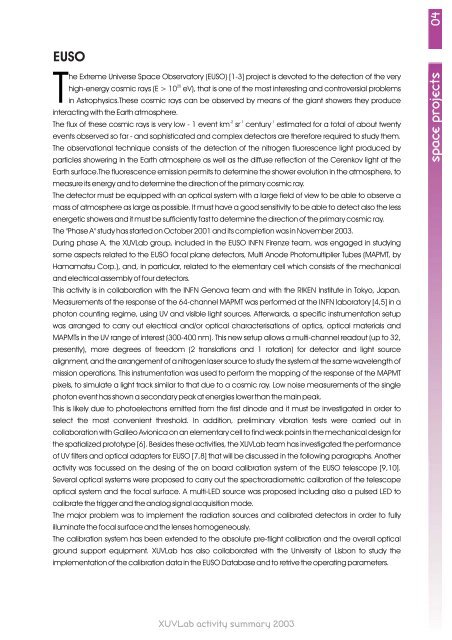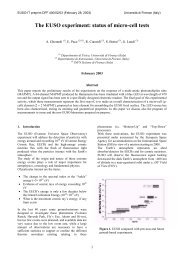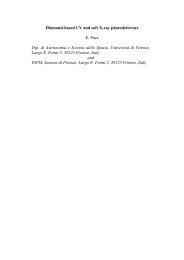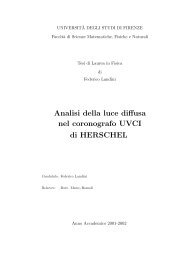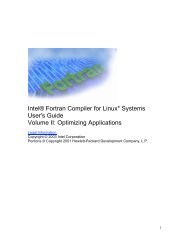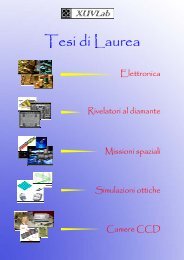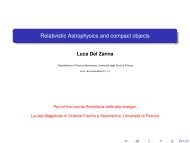2003 - Astronomia - Università degli Studi di Firenze
2003 - Astronomia - Università degli Studi di Firenze
2003 - Astronomia - Università degli Studi di Firenze
Create successful ePaper yourself
Turn your PDF publications into a flip-book with our unique Google optimized e-Paper software.
EUSO<br />
The Extreme Universe Space Observatory (EUSO) [1-3] project is devoted to the detection of the very<br />
20<br />
high-energy cosmic rays (E > 10 eV), that is one of the most interesting and controversial problems<br />
in Astrophysics.These cosmic rays can be observed by means of the giant showers they produce<br />
interacting with the Earth atmosphere.<br />
-2 -1 -1<br />
The flux of these cosmic rays is very low - 1 event km sr century estimated for a total of about twenty<br />
events observed so far - and sophisticated and complex detectors are therefore required to study them.<br />
The observational technique consists of the detection of the nitrogen fluorescence light produced by<br />
particles showering in the Earth atmosphere as well as the <strong>di</strong>ffuse reflection of the Cerenkov light at the<br />
Earth surface.The fluorescence emission permits to determine the shower evolution in the atmosphere, to<br />
measure its energy and to determine the <strong>di</strong>rection of the primary cosmic ray.<br />
The detector must be equipped with an optical system with a large field of view to be able to observe a<br />
mass of atmosphere as large as possible. It must have a good sensitivity to be able to detect also the less<br />
energetic showers and it must be sufficiently fast to determine the <strong>di</strong>rection of the primary cosmic ray.<br />
The "Phase A" study has started on October 2001 and its completion was in November <strong>2003</strong>.<br />
During phase A, the XUVLab group, included in the EUSO INFN <strong>Firenze</strong> team, was engaged in studying<br />
some aspects related to the EUSO focal plane detectors, Multi Anode Photomultiplier Tubes (MAPMT, by<br />
Hamamatsu Corp.), and, in particular, related to the elementary cell which consists of the mechanical<br />
and electrical assembly of four detectors.<br />
This activity is in collaboration with the INFN Genova team and with the RIKEN Institute in Tokyo, Japan.<br />
Measurements of the response of the 64-channel MAPMT was performed at the INFN laboratory [4,5] in a<br />
photon counting regime, using UV and visible light sources. Afterwards, a specific instrumentation setup<br />
was arranged to carry out electrical and/or optical characterisations of optics, optical materials and<br />
MAPMTs in the UV range of interest (300-400 nm). This new setup allows a multi-channel readout (up to 32,<br />
presently), more degrees of freedom (2 translations and 1 rotation) for detector and light source<br />
alignment, and the arrangement of a nitrogen laser source to study the system at the same wavelength of<br />
mission operations. This instrumentation was used to perform the mapping of the response of the MAPMT<br />
pixels, to simulate a light track similar to that due to a cosmic ray. Low noise measurements of the single<br />
photon event has shown a secondary peak at energies lower than the main peak.<br />
This is likely due to photoelectrons emitted from the first <strong>di</strong>node and it must be investigated in order to<br />
select the most convenient threshold. In ad<strong>di</strong>tion, preliminary vibration tests were carried out in<br />
collaboration with Galileo Avionica on an elementary cell to find weak points in the mechanical design for<br />
the spatialized prototype [6]. Besides these activities, the XUVLab team has investigated the performance<br />
of UV filters and optical adapters for EUSO [7,8] that will be <strong>di</strong>scussed in the following paragraphs. Another<br />
activity was focussed on the desing of the on board calibration system of the EUSO telescope [9,10].<br />
Several optical systems were proposed to carry out the spectrora<strong>di</strong>ometric calibration of the telescope<br />
optical system and the focal surface. A multi-LED source was proposed inclu<strong>di</strong>ng also a pulsed LED to<br />
calibrate the trigger and the analog signal acquisition mode.<br />
The major problem was to implement the ra<strong>di</strong>ation sources and calibrated detectors in order to fully<br />
illuminate the focal surface and the lenses homogeneously.<br />
The calibration system has been extended to the absolute pre-flight calibration and the overall optical<br />
ground support equipment. XUVLab has also collaborated with the University of Lisbon to study the<br />
implementation of the calibration data in the EUSO Database and to retrive the operating parameters.<br />
XUVLab activity summary <strong>2003</strong><br />
space projects 04


